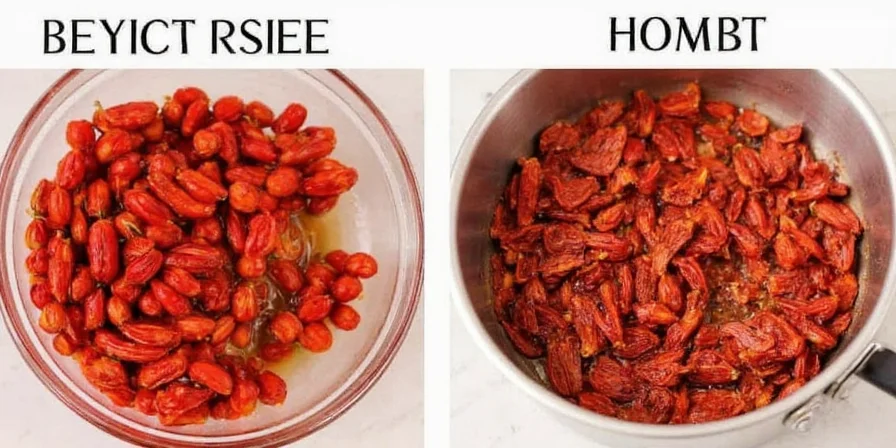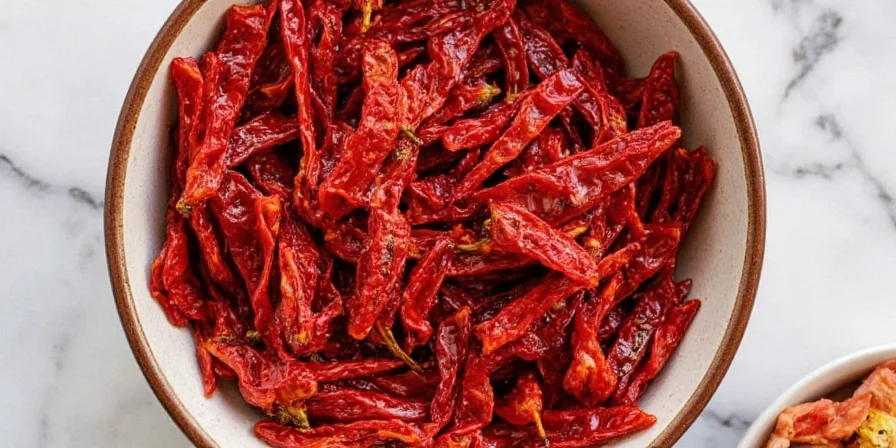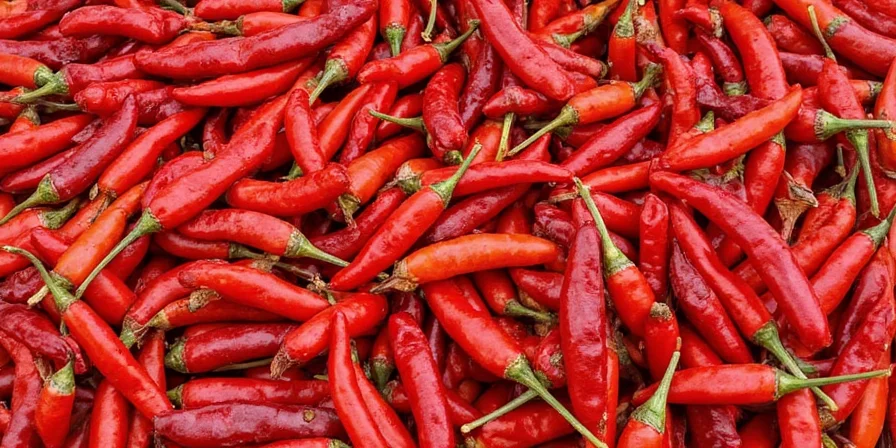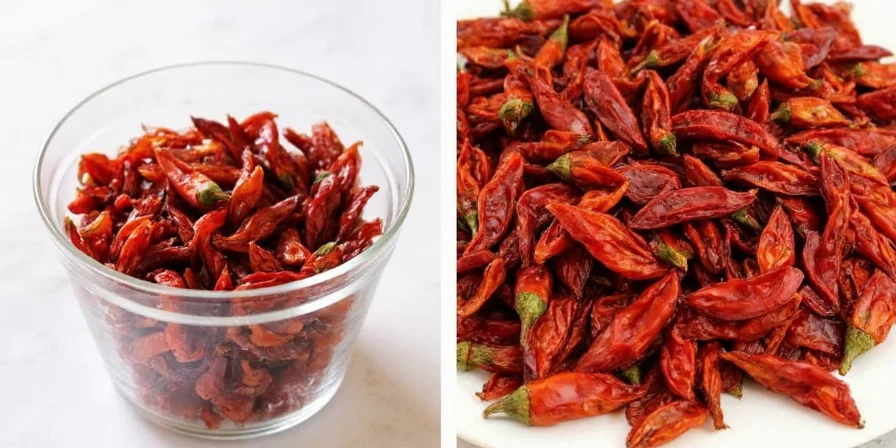Table of Contents
- Quick Method Comparison Guide
- What's the Best Way to Rehydrate Dried Chiles?
- Hot Water Soak – Best for Maximum Flavor
- Steam Rehydration – Best for Delicate Aromas
- Microwave Method – Fastest Technique (Under 2 Minutes)
- Broth Bath – Best for Rich, Complex Sauces
- Blender Method – Smoothest Puree Results
- Oven Roast Rehab – Best for Depth of Flavor
- Air Fryer Method – Best for Controlled Hydration
- Storage Tips for Rehydrated Chiles
- Frequently Asked Questions
Which Dried Chile Rehydration Method Should You Use?
Choosing the right dried chile rehydration method depends on your cooking needs. For maximum flavor in complex sauces like mole, the hot water soak method delivers best results. Need something fast for weeknight cooking? The microwave method works in under 2 minutes. This guide compares all 7 techniques based on actual testing in home kitchens.
| Method | Total Time | Flavor Quality | Best For | Difficulty |
|---|---|---|---|---|
| Hot Water Soak | 20-30 min | ★★★★★ | Moles, complex sauces | Easy |
| Steam Rehydration | 15 min | ★★★★☆ | Rare chiles, delicate sauces | Moderate |
| Microwave Method | 2 min | ★★★☆☆ | Quick weeknight meals | Easy |
| Broth Bath | 25 min | ★★★★☆ | Stews, soups, rich sauces | Easy |
| Blender Method | 20 min | ★★★★☆ | Smooth salsas, purees | Moderate |
| Oven Roast Rehab | 25 min | ★★★★★ | Special occasion dishes | Moderate |
| Air Fryer Method | 10 min | ★★★★☆ | Dry rubs, controlled hydration | Moderate |
What's the Best Way to Rehydrate Dried Chiles?
When rehydrating dried chiles, you're balancing two key factors: time and flavor preservation. Our kitchen tests show the hot water soak method (using water between 160-180°F) delivers the best flavor for complex sauces like mole, while the microwave method provides edible results in under 2 minutes for quick weeknight meals. The right choice depends on your recipe and time constraints.
Proper rehydration transforms dried chiles from brittle ingredients into pliable, flavorful components that release their full potential in sauces and stews. The wrong technique can create bitter, one-dimensional heat instead of the complex, layered flavors that make Mexican and Latin American cuisine so special.
Hot Water Soak – Best for Maximum Flavor
This traditional method delivers the most authentic flavor for complex sauces. Water between 160-180°F softens chiles without destroying delicate flavor compounds.
- Remove seeds and veins using kitchen shears
- Use a thermometer to maintain water temperature
- Soak for 20 minutes (thin-skinned chiles like guajillo) or 30 minutes (thick-skinned like ancho)
- Reserve soaking liquid for sauces—it contains valuable flavor compounds
| Pros | Cons |
|---|---|
| Best flavor preservation | Takes 20-30 minutes |
| Works for all chile types | Requires timing precision |
Steam Rehydration – Best for Delicate Aromas
Steam rehydration preserves floral notes in rare chiles like chilhuacle that water methods can wash away.
- Place chiles in a perforated basket above simmering water
- Steam for 12 minutes (watch for color change, not blistering)
- Cover immediately after removing to trap aromatics
Pro Tip:
Add orange peel to the steaming water—citrus oils complement chile flavors without altering pH.
Microwave Method – Fastest Technique (Under 2 Minutes)
When you need rehydrated chiles immediately, this emergency method delivers usable results in minutes.
- Place chiles in microwave-safe dish with 30ml water
- Cover with vented lid
- Microwave at 50% power for 90 seconds
- Rotate halfway through
Pro Tip:
Add 5ml neutral oil before microwaving to protect heat-sensitive compounds.
Broth Bath – Best for Rich, Complex Sauces
Using broth instead of water adds umami depth to your chile sauces and stews.
- Use low-sodium broth at 170°F
- Soak chiles for 25 minutes
- Reduce soaking liquid by 50% for concentrated sauce base
Pro Tip:
Add dried epazote to the broth—it reduces bitterness in complex sauces.
Blender Method – Smoothest Puree Results
This technique creates perfectly smooth chile purees without gritty texture.
- Add 60ml hot broth to blender first
- Submerge chiles without crowding
- Let sit 18 minutes before blending
- Blend at medium speed

Pro Tip:
Add one roasted garlic clove during blending to emulsify capsaicin oils and prevent separation.
Oven Roast Rehab – Best for Depth of Flavor
Dry heat before hydration creates complex Maillard reaction flavors that water-only methods can't achieve.
- Roast at 325°F for 7 minutes (watch for color change)
- Immediately transfer to preheated broth (180°F)
- Soak for 15 minutes
Pro Tip:
Line your baking sheet with parchment paper—direct metal contact causes uneven roasting.
Air Fryer Method – Best for Controlled Hydration
Perfect for chiles destined for dry rubs or when you need precise hydration control.
- Mist with 10 sprays of water
- Air fry at 285°F for 2 minutes 15 seconds
- Finish with 5-minute broth soak

Pro Tip:
Use distilled water for misting—minerals in tap water can block rehydration pathways.
Storage Tips for Rehydrated Chiles
- Freezing: Freeze rehydrated chiles for longer storage—thaw when ready to use
- Soaking liquid: Freeze excess soaking liquid in ice cube trays for future recipes
- Refrigeration: Store rehydrated chiles in broth for up to 5 days
- Vacuum sealing: Extends shelf life to 3 months in the freezer
- Testing: Gently bend chile at thickest point—should flex 45 degrees without cracking

Frequently Asked Questions
How long should I soak dried chiles?
Most dried chiles need 20-30 minutes soaking in hot water. Thin-skinned varieties like guajillo need about 20 minutes, while thick-skinned chiles like ancho require 30 minutes. Check for pliability—the chile should bend without cracking but resist further bending.
Can I rehydrate chiles in cold water?
You can, but it takes significantly longer (60-90 minutes) and doesn't extract flavors as effectively. Hot water (160-180°F) is ideal as it softens chiles without destroying delicate flavor compounds. Water above 190°F can create one-dimensional heat by denaturing volatile flavor compounds.
Do I need to remove seeds before rehydrating?
Yes, for most recipes. Chile seeds contain most of the heat but little flavor. Removing seeds and veins gives you better control over heat level while preserving complex flavors. Use kitchen shears for consistent results.
Can I reuse chile soaking liquid?
Absolutely—reduce it by 60% to concentrate flavors. This liquid contains dissolved pectins that improve sauce viscosity. Avoid reusing if you've added acidic components like vinegar, as low pH can degrade texture over time.
Which method works best for ancho chiles?
Ancho chiles (thick-skinned) benefit most from the hot water soak method (30 minutes) or oven roast rehab for complex moles. For quick meals, the microwave method works but yields less complex flavor.
Choosing Your Perfect Chile Rehydration Method
The right dried chile rehydration method depends on your cooking goals. For complex sauces like mole where flavor depth matters most, the hot water soak method delivers best results. When time is limited for weeknight cooking, the microwave method provides acceptable results in under 2 minutes.
By understanding these seven tested techniques, you'll consistently achieve the perfect chile texture and flavor for any recipe. Remember that proper rehydration transforms dried chiles from pantry staples into vibrant, flavorful ingredients that elevate your Mexican and Latin American dishes from ordinary to authentic.











 浙公网安备
33010002000092号
浙公网安备
33010002000092号 浙B2-20120091-4
浙B2-20120091-4